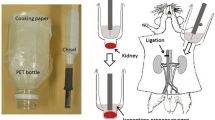Abstract
Using the in vitro microperfusion technique on isolated rat papillary collecting duct (PCD), we examined whether the glutaraldehyde-fixation method can be also applied to the mammalian collecting duct for preservation of the vasopressin-stimulated water and urea transport. Arginine vasopressin (AVP) at 10−9 mol/l increased diffusional water permeability (P dw) from 101.9±10.76 to 283.3±16.67×10−7 cm2 s−1 (n=8,P<0.01) and urea permeability (P urea) from 30.3±2.24 to 83.5±7.80×10−7 cm2 s−1 (n=8,P<0.01). Both parameters remained elevated after fixation with 0.1 mol/l glutaraldehyde even in the absence of AVP, with the values being 265.0±14.47 and 74.5±7.15×10−7 cm2 s−1, respectively. Glutaraldehyde fixation did not affect the basal levels ofP dw orP urea. Phloretin at 2.5×10−4 mol/l decreased glutaraldehyde-fixed AVP-stimulatedP urea from 79.0±7.96 to 29.7±3.66×10−7 cm2 s−1 (n=4,P<0.01) and from 73.2±7.05 to 38.7±3.53×10−7 cm2 s−1 (n=4,P<0.01) when the drug was added to the lumen or to the bath, respectively. Phloretin also decreased glutaraldehyde-fixed non-stimulatedP urea by 25–40%. However, this drug did not affect glutaraldehyde-fixedP dw. These findings indicate that the glutaraldehyde fixation method can be applied to mammalian collecting tubules for studying vasopressin stimulatedP dw andP urea.P urea fixed by glutaraldehyde is functionally flexible and may be distinct from the water pathway.
Similar content being viewed by others
References
Burg MB, Granthan J, Abramow M, Orloff J (1966) Preparation and study of fragments of single rabbit nephron. Am J Physiol 210:1293–1298
Carvounis CP, Franki N, Levine SD, Hays RM (1979) Membrane pathways for water and solutes in the toad bladder. I. Independent activation of water and urea transport. J Membr Biol 49:253–268
Carvounis CP, Levine SD, Franki N, Hays RM (1979) Membrane pathways for water and solutes in the toad bladder. II. Reflexion coefficients of water and solute channels. J Membr Biol 49:269–287
Chevalier J, Bourguet J, Hugon JS (1974) Membrane associated particles: distribution in frog urinary bladder epithelium at rest and after oxitocin treatment. Cell Tissue Res 152: 129–140
Curci S, Casavola V, Cremaschi D, Lippe C (1976) Facilitated transport of urea across the toad gall bladder. Pflügers Arch 362:109–112
Eggena P (1972) Glutaraldehyde fixation method for determining the permeability to water of the toad urinary bladder. Endocrinology 91:240–246
Eggena P (1972) Osmotic regulation of toad bladder responsiveness to neurohypophyseal hormones. J Gen Physiol 60:665–678
Eggena P (1973) Inhibition of vasopressin-stimulated urea transport across the toad bladder by thiourea. J Clin Invest 52:2963–2970
Eggena P (1983) Effect of glutaraldehyde on hydrosmotic response of toad bladder to vasopressin. Am J Physiol 244:C37-C43
Eggena P, Gibas A (1983) Activation energy for water transport in toad bladder. Am J Physiol 244:C44-C49
Hall DA, Grantham JJ (1980) Temperature effect on ADH response of isolated perfused rabbit collecting tubules. Am J Physiol 239:F595-F601
Hardy M (1985) Urea and Na+ permeability in toad urinary bladder: one or two solute pathways?. Am J Physiol 248:F 56-F 63
Hardy M, DiBona DR (1982) Microfilament and hydrosmotic action of vasopressin in toad urinary bladder. Am J Physiol 243:C 200-C 204
Hardy M, DiBona DR (1982) Extracellular Ca2+ and the effect of antidiuretic hormone on the water permeability. J Membr Biol 67:27–44
Kawamura S, Kokko JP (1976) Urea secretion by the straight segment of the proximal tubules. J Clin Invest 58:604–612
Levine S, Franki N, Hays RM (1973) Effect of phloretin on water and solute movement in the toad bladder. J Clin Invest 52:1435–1442
Macey RJ, Farmer REL (1970) Inhibition of water and solute permeability in human red cells. Biochim Biophys Acta 211:104–106
Morgan T, Berliner RW (1968) Permeability of the loop of Henle, vasa recta, and collecting duct to water, urea and sodium. Am J Physiol 215:108–115
Muller J, Kachadorian WA, DiScala VA (1980) Evidence that ADH-stimulated intramembrane particle aggregate are transferred from cytoplasmic to luminal membranes in toad bladder epithelial cells. J Cell Biol 85:83–95
Parisi M, Merot J, Bourguet J (1985) Glutaraldehyde fixation preserves the permeability properties of the ADH-induced water channels. J Membr Biol 86:239–245
Petrucelli RJ, Eggena P (1982) Improtance of molecular size and hydrogen bonding in vasopressin-stimulated urea transport. Am J Physiol 243:C 27-C 34
Rapoport J, Kachadorian WA, Muller J, Franki N, Hays RM (1981) Stabilization of vasopressin-induced membrane events by bifunctional imidoesters. J Cell Biol 89:261–266
Rocha AS, Kokko JP (1974) Permeability of medullary nephron segments to urea and water: effect of vasopressin. Kidney Int 6:376–387
Rocha AS, Kudo LH (1982) Water, urea, sodium, chloride, and potassium transport in the in vitro isolated perfused papillary collecting duct. Kidney Int 22:485–491
Schafer JA, Andreoli TE (1972) The effect of antidiuretic hormone on solute flows in mammalian collecting tubules. J Clin Invest 51:1279–1286
Schuchter SH, Franki N, Hays RM (1973) The effect of tanning agents on the permeability of the toad bladder to water and solutes. J Membr Biol 14:177–191
Wade JB, Stetson DL, Lewis SA (1981) ADH action: evidence for a membrane shuttle mechanism. Ann NY Acad Sci 372:106–117
Author information
Authors and Affiliations
Rights and permissions
About this article
Cite this article
Kondo, Y., Imai, M. Effects of glutaraldehyde fixation on renal tubular function. Pflugers Arch. 408, 479–483 (1987). https://doi.org/10.1007/BF00585072
Received:
Accepted:
Issue Date:
DOI: https://doi.org/10.1007/BF00585072




